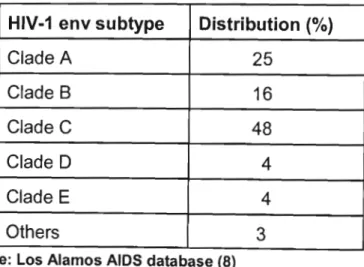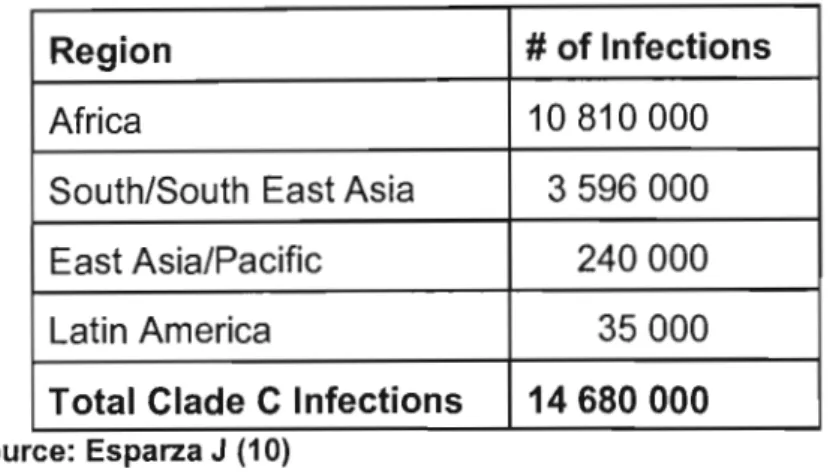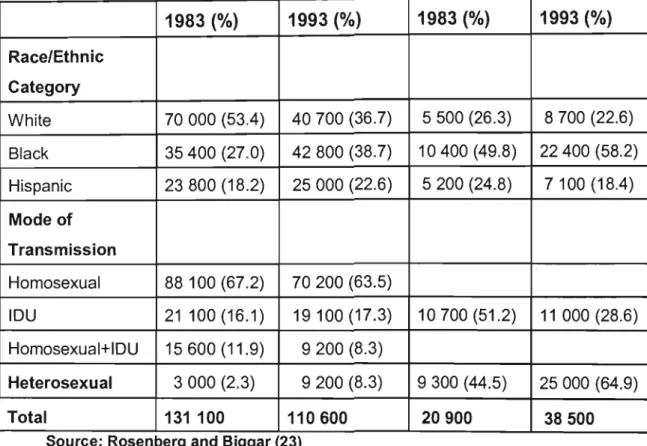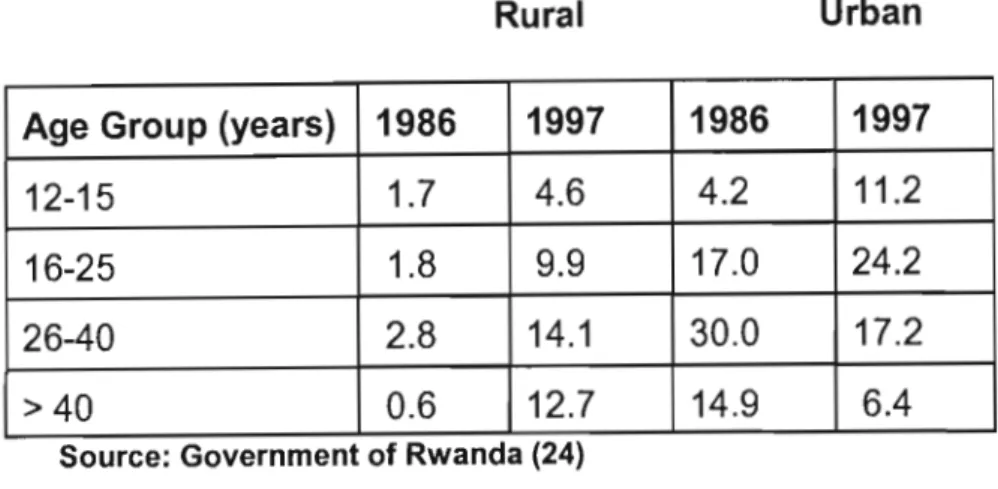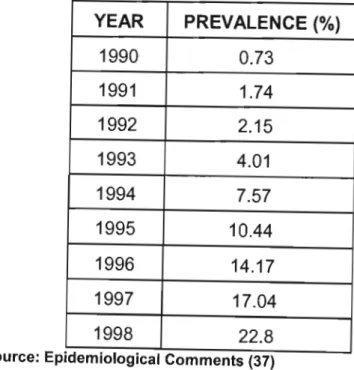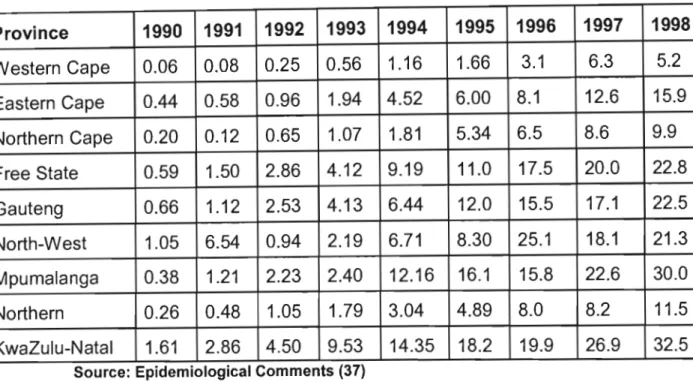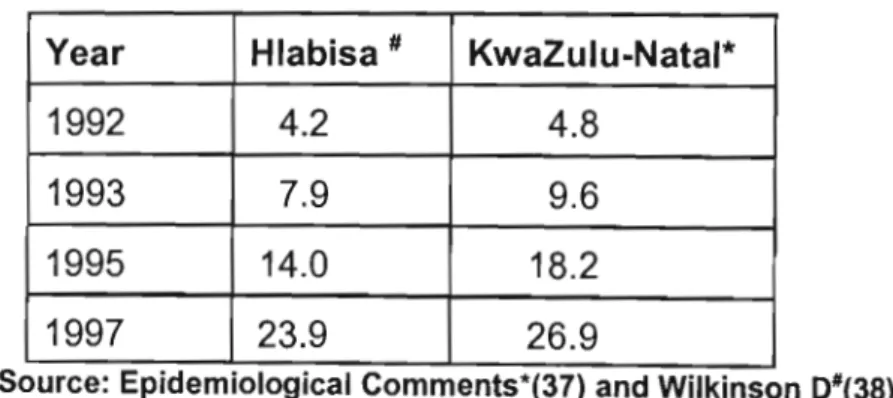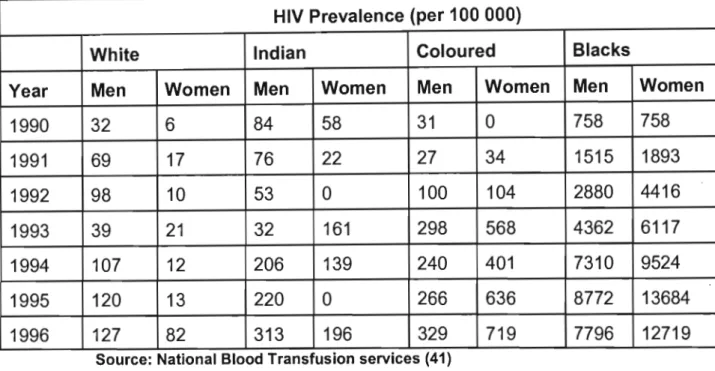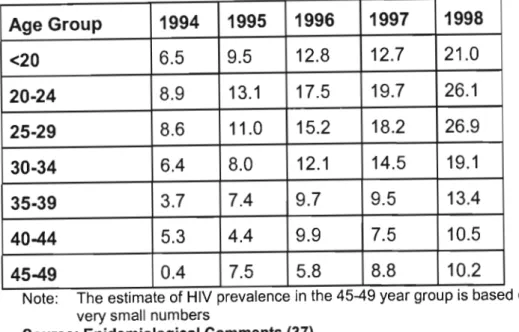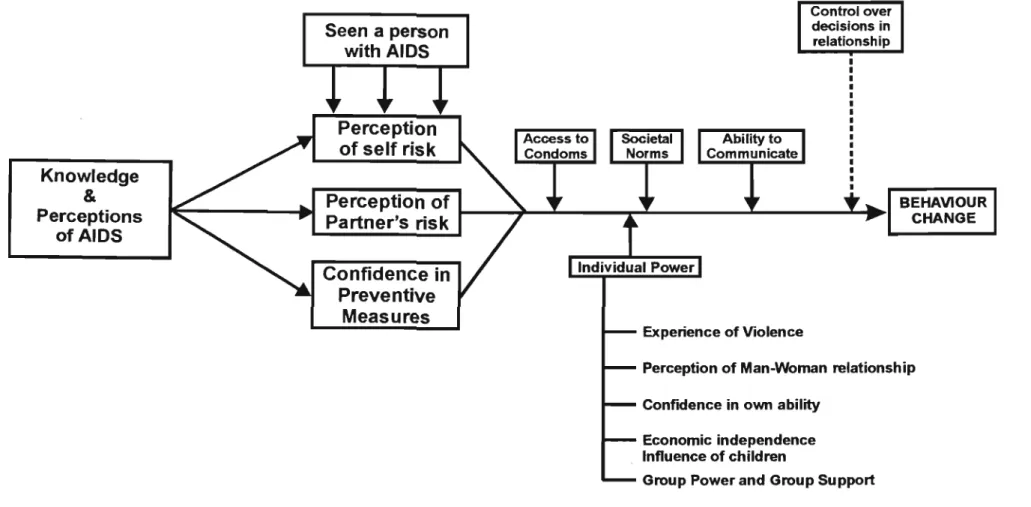Abdool Karim Q, Abdool Karim SS, Singh B, Short R, Ngxongo S. Seroprevalence of HIV infection in rural South Africa. Abdool Karim Q, Abdool Karim SS, Soldan K, Zondi M. Reducing the risk of HIV infection among South African sex workers:.
Contents
List of Abbreviations
List of Tables
SUMMARY
Background
- Global Overview
- New and Emerging Epidemics
- South Africa: Host to a New and Emerging Epidemic
- Understanding Behaviour Change 1. Introduction
- Scope of the research
The HIV epidemic in Rwanda highlights the stabilization of the HIV epidemic in some subgroups that mask new subgroups acquiring HIV infection. So far, our understanding of the epidemic in the region is based on anonymous screening of pregnant women.
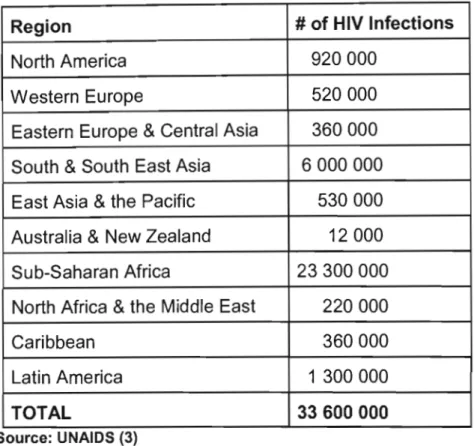
Chapter 2: Purpose, Objectives and Ethics
- Purpose
- Objectives
- Ethical Considerations
Each of the studies comprising the research carried out for the completion of this doctoral thesis was approved by the Ethics Committee of the Faculty of Medicine, University of Natal.
Overview of dissertation, Summary of the study sites and study
- Overview of dissertation
- Summary of study sites, study populations, sample size and study design
- Selection of sites and participant involvement in the research
4 Gender differences in HIV East Coast of KwaZulu- Residents in the Malaria 5023 Cross- Convenience Questionnaire + HIV Natal north of the Tugela Control Program cross-sectional sample antibody EIA and Western. Women's group was actively involved in the research and used the results of the survey to design an educational intervention for women in this community.
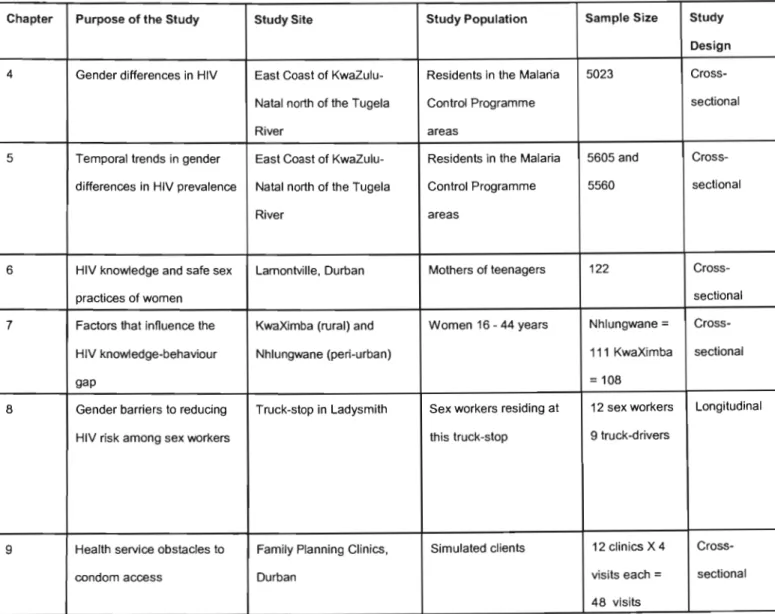
Quantifying the gender difference in HIV prevalence: A
- Introduction
- Purpose
- Methods
- Results
- Discussion
- Conclusion
- Temporal changes in gender differences as an explosive epidemic
The prevalence of HIV-1 infection in the malaria sectors that crossed the main national road (Figure 2) was 1.3%, compared to 0.9% in the other malaria sectors (p=not significant). The high prevalence of HIV-1 infection among women in the age group 15-44 years indicates the potential for vertical transmission of HIV-1 to newborns. Furthermore, the spatial distribution of HIV-1 infection (Figure 2) did not indicate clustering of HIV-1 infection in the vicinity of the main road.
While at an early stage of the epidemic, women in these communities already bear a disproportionate burden of HIV infection.
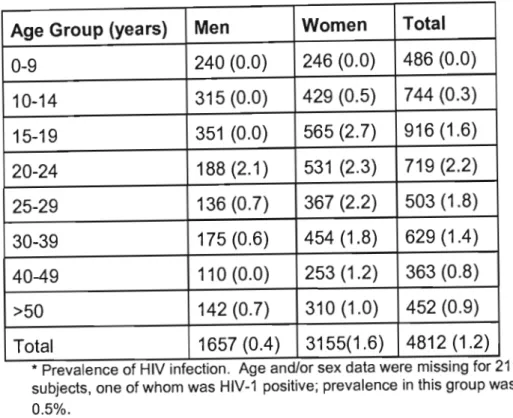
- Introduction
- Purpose
- Methods
- Results
- Discussion
- Conclusion
- The HIV knowledge-
To monitor time trends in gender differences in the HIV epidemic in rural KwaZulu-Natal. HIV infection in young women will result in a narrowing of the pyramid, with more men surviving at younger ages. The HIV epidemic in rural KwaZulu-Natal was still in its early stages but progressed rapidly.
Furthermore, differences in the age of infection between men and women appear to be a key factor in gender differences in HIV.

Natal
Introduction
While gender differences have narrowed over time from 4 times more infection in women compared to men in 1990 to 1.5 times in 1992, HIV infection remains more common in women; and. To date, several studies (130-132) of HIV knowledge, attitudes, practices and beliefs (KAPB) have demonstrated a weak correlation between knowledge and adoption of safer sex practices. Little is known or understood about the complex factors that mediate between HIV knowledge and the adoption of safer sex practices, particularly for women in the general population.
Purpose
Methods
- Study Sites
Since 1990 there has been peace and stability in the area and the community is trying to rebuild itself after the years of unrest and instability. The community is involved in the decision-making processes for the development of the area. There are approximately 120 organizations in the area including civic, women's, youth, religious, funeral and extra-parliamentary political organizations.
There is a health clinic in the area that serves the entire community of KwaXimba.
Results
- Sociodemography
Data on decision-making among condom users regarding condom use and access to condoms are presented in Table 26. Data on respondents' ability to ask their current partner for safer sex are presented in Table 30. Data on how respondents perceive the ability to ask a new partner on adoption of HIV risk reduction behaviors are presented in Table 31.
Data on respondents' perceptions of friends' attitudes toward safer sex practices are shown in Table 33.
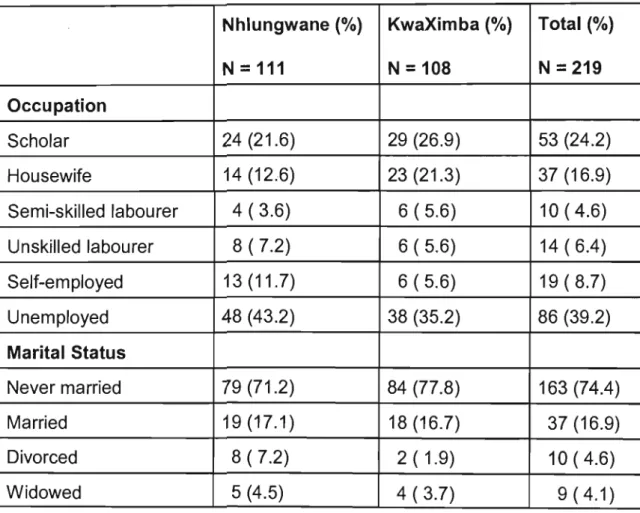
Discussion
One third of the women in Nhlungwane and 47.2% in KwaXimba believed that their partner had other partners. In addition, 48.7% of women from Nhlungwane and 56.5% from KwaXimba did not believe they had the right to insist on condom use if their partner put them at risk of HIV infection. Furthermore, 49.5% of women from Nhlungwane and 59.3% from KwaXimba believed that men have the right to multiple partners.
The majority of women in this study are financially dependent on their partners; 70.2% from Nhlungwane and 78.7% from KwaXimba respectively.
Conclusion
The HIV knowledge-
Introduction
Purpose
Methods
A mother qualified for inclusion in this study if she had at least one teenage child. In homes where there was more than one eligible mother, only one randomly selected mother was included in the study. When an eligible mother was found, the purpose of the study was explained to her and she was assured that the information provided would be treated as strictly confidential.
It should be noted that the questionnaire used in the pilot study included several questions about sexual partners, which were excluded from the final questionnaire because most mothers refused to answer these questions in the pilot study.
Results
- Communication between mothers and their teenage children
Having one partner and using male condoms were indicated by 95.9% and 97.5% of mothers, respectively, as mechanisms to prevent the spread of HIV. Two thirds of mothers believed that AIDS can be cured by treatment from a doctor and 9.8% said that muti (traditional medicine) from the traditional healer (inyanga) can cure AIDS. Concern about the AIDS epidemic was common, with 67.2% of mothers expressing interest in supporting a local campaign against AIDS.
Most mothers (97.8%) who had teenage daughters thought their daughters should have their first child only after marriage, 1.1% said after finishing school but not necessarily before having a job, and 1.1% said only after they had started a job.
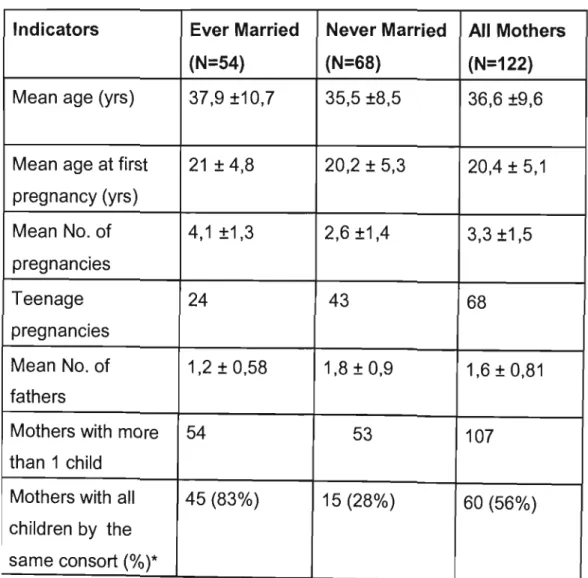
Discussion
Although the risk of HIV infection is clearly substantial, it should be noted that our study underestimates the risk because direct questions about the number of sex partners were avoided and used. This study therefore focused primarily on the women's AIDS prevention behavior by determining whether she used condoms and communicated the risks of HIV to her teenage children. However, it was of great concern that mothers had not yet introduced condom use to reduce their risk of acquiring HIV infection, despite their extensive knowledge of HIV transmission mechanisms and prevention strategies.
It was disappointing to find that mothers in this study did not communicate the risk of HIV infection to their teenage children.
Conclusion
Gender barriers to reducing HIV risk: The case of sex work at truck-stops
- Introduction
- Purpose
- Methods
- Study Procedure
- Results
- Socio-demography
- Sexually Transmitted Diseases and Contraception
- Condoms
- S. Discussion
- Conclusion
Women who work at truck stops are typically at the upper end of the scale for risk of HIV infection (172). At the end of the consultative meeting, the sex workers held their own meeting to elect an individual for that purpose. The majority of the sex workers described having regular clients as well as clients they did not know at all.
Therefore, the information may not be representative of truck drivers or customers visiting the truck stop.
Gender barriers to reducing HIV risk: Health service obstacles to condom
Introduction
Additionally, family planning service providers act as gatekeepers to contraception and are key in influencing user patterns, acceptance, and continued use (204,205). Family planning services in South Africa are the main distributors of condoms to the public and potentially have an important role to play in improving access to them, particularly for adolescents who are known to be a high-risk group for HIV infection.
Purpose
Methods
Content analysis (207) of field reports was performed and interpretation checked for consistency with original reports of clinic visits. The study was approved by the Ethics and Professional Standards Committee of the Faculty of Medicine, University of Natal. Permission for the research was granted by the Durban Medical Officer of Health and the Provincial Director of Family Planning Services, but clinic staff were not aware of the study until the clinic visits were completed.
To prevent victimization, names of the clinic staff were not recorded and the findings cannot be attributed to any specific clinic.
Results
- AIDS posters
- Attitude of clinic staff
- Information provided during the consultation
- Gender differences in the service provided
- Contraceptive focus
In one clinic, two of the field workers felt they were receiving negative treatment and interpreted this in racial terms. The field workers were not required to fill in a record card and usually no questions were asked. When the field workers asked for instructions, the clinic staff seemed taken aback—especially when the request came from a man.
In two cases, condoms were not given to the field workers because they were out of stock.
Discussion
This single-minded focus on fertility control is a reflection of the limitations of vertical prevention programs. The transformation of health care service provision currently underway in South Africa (212) with an emphasis on integrated primary health care services is a first step towards the provision of improved primary health care services. Included in core services to be provided at all health care centers are HIV, STDs, and contraception (212).
Since the majority of caregivers are women, the type of training provided could also improve caregivers' assessment of their personal risk for HIV.
Conclusion
A critical issue was the provider's emphasis and promotion of what they felt were the best methods of fertility control. Training staff in these facilities to meet the demand of this expanded role will go a long way toward better access to HIV prevention services for users. Outside of South Africa there has been growing recognition of the importance of family planning staff in enhancing HIV prevention efforts and some calls for this.
The need for staff to recognize the importance of condom promotion for disease prevention as an adjunct to other more reliable fertility control methods being promoted is highlighted.
Conclusion and . Recommendations
- Conclusion
- Recommendations
HIV infection was 3.1 times (CI: 1.7-6.0) more common among mobile residents/migrants compared to their more stable counterparts. High rates of HIV infection among young women appear to be key to the growing HIV epidemic in rural South Africa. Population-based studies not only show distinct gender patterns in HIV infection, but also highlight a persistent difference in risk between men and women over time.
Not only are women at high risk of acquiring HIV infection, but it is especially young women who are at greater risk.
Monitoring HIV infection levels and trends: the Public Health Service HIV Surveillance Programme. The impact of social influences in the context of attitude, self-efficacy, intention and past behavior as predictors of smoking. Sexual behavior of long-haul truck drivers and their contribution to the spread of sexually transmitted diseases and HIV infection in East Africa.
Circular migration and sexual networking in rural KwaZulu/Natal: implications for the spread of HIV and other sexually transmitted diseases.
